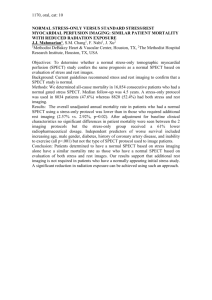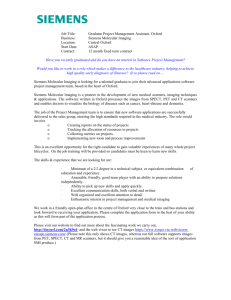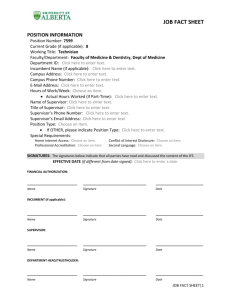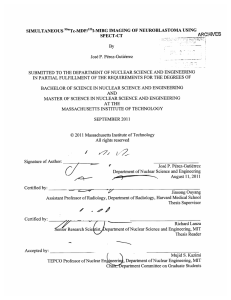appendix
advertisement
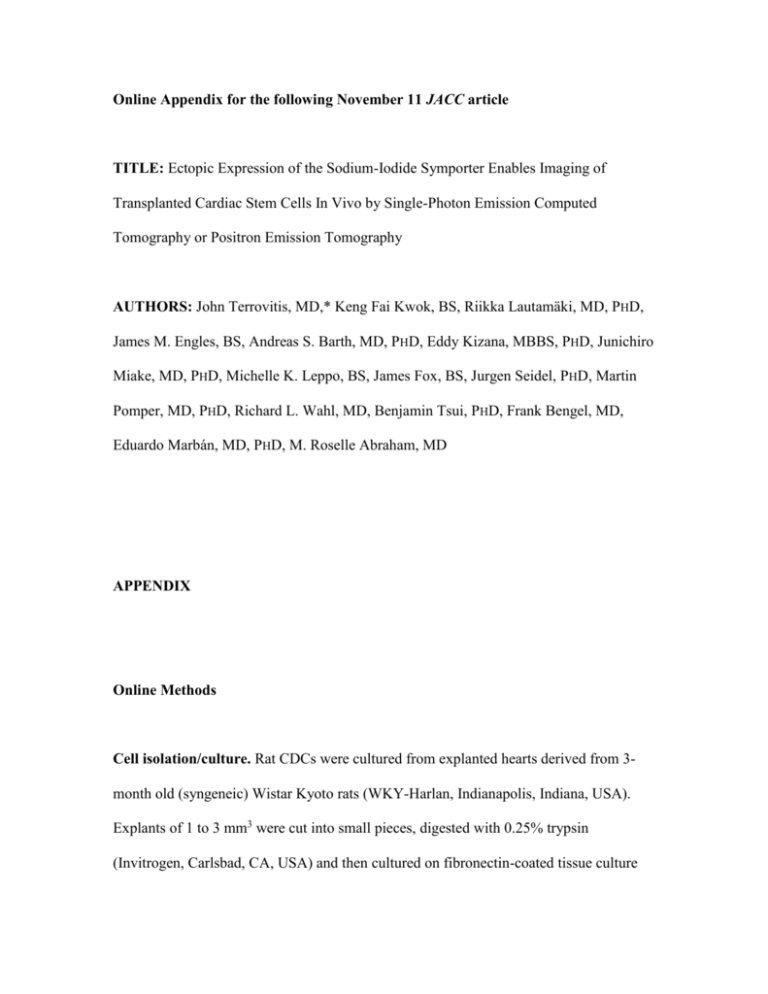
Online Appendix for the following November 11 JACC article TITLE: Ectopic Expression of the Sodium-Iodide Symporter Enables Imaging of Transplanted Cardiac Stem Cells In Vivo by Single-Photon Emission Computed Tomography or Positron Emission Tomography AUTHORS: John Terrovitis, MD,* Keng Fai Kwok, BS, Riikka Lautamäki, MD, PHD, James M. Engles, BS, Andreas S. Barth, MD, PHD, Eddy Kizana, MBBS, PHD, Junichiro Miake, MD, PHD, Michelle K. Leppo, BS, James Fox, BS, Jurgen Seidel, PHD, Martin Pomper, MD, PHD, Richard L. Wahl, MD, Benjamin Tsui, PHD, Frank Bengel, MD, Eduardo Marbán, MD, PHD, M. Roselle Abraham, MD APPENDIX Online Methods Cell isolation/culture. Rat CDCs were cultured from explanted hearts derived from 3month old (syngeneic) Wistar Kyoto rats (WKY-Harlan, Indianapolis, Indiana, USA). Explants of 1 to 3 mm3 were cut into small pieces, digested with 0.25% trypsin (Invitrogen, Carlsbad, CA, USA) and then cultured on fibronectin-coated tissue culture dishes using media (complete explant media, referred to as CEM) consisting of Iscove’s Modified Dulbecco’s Medium (IMDM, Invitrogen), supplemented with 20% fetal calf serum, 100 U/ml penicillin G, 100 µg/ml streptomycin, 2 mmol/l L-glutamine, and 0.1 mmol/l 2-mercaptoethanol. In the following 2 weeks, a layer of fibroblast-like adherent cells and a smaller number of small phase-bright cells migrated from the explants. The latter cells were collected by pooling one washing with Ca2+-Mg2+-free PBS, one wash with 0.53 mmol/l EDTA (Invitrogen), and one wash with 0.5 g/l trypsin and 0.53 mmol/l EDTA (Invitrogen) at room temperature under visual control. The harvested cells were then seeded in poly-D-lysine coated multiwell plates (2 × 104 cells/well), in media containing 35% IMDM/65% DMEM-Ham F-12 (Invitrogen) containing 2% B27, 0.1 mmol/l 2-mercaptoethanol, 10 ng/ml epidermal growth factor (Peprotech, Rockville, NJ, USA), 20 ng/ml basic fibroblast growth factor (Peprotech), 40 nmol/l cardiotrophin-1 (Peprotech), 40 nmol/l thrombin (Peprotech), antibiotics, and L-Glutamine. Under these conditions, the cells aggregate in spherical formations (cardiospheres) in 5–10 days; these cardiospheres were harvested, seeded in fibronectin-coated tissue culture flasks for expansion as monolayers and cultured in CEM. These cells when grown as monolayers express several stem cell markers and are referred to as cardiosphere-derived stem cells or CDCs. Lentivirus preparation. A third-generation lentiviral vector system (kindly supplied by Professor Inder Verma, Salk Institute, USA) was used to label the rCDCs. The cDNA encoding the human sodium iodide symporter gene (hNIS, kind gift from Dr. Jhiang, Ohio) was subcloned in place of eGFP into the vectors pRRLsin18.cPPT.CAG.eGFP.Wpre or pRRLsin18.cPPT.CMV.eGFP.Wpre resulting in plasmids designated cPPT.CAG.hNIS and cpPPT.CMV.hNIS, respectively. Viral vectors were produced by Lipofectamine 2000 (Invitrogen) transfection of four lentiviral vector plasmids into 293T cells (ATCC, Manassas, VA, USA). Vector-containing supernatant was collected 48 and 72 hours after transfection, filtered (0.45 μm, cellulose acetate, Corning, Acton, MA, USA), and concentrated by ultrafiltration (100,000 MWCO, Centricon Plus-70, Millipore, Billerica, MA, USA). Viral titer was assigned on concentrated supernatant by HIV-1 p24 ELISA (Dupont, Wilmington, DE, USA). For genetic labeling, rCDCs were transduced at a multiplicity of infection of 25 yielding transduction efficiencies of >70%. NIS expression in transduced cells was confirmed by immunostaining using a monoclonal mouse anti-hNIS antibody (Abcam, Cambridge, MA, USA) and by an in-vitro 99mTc (pertechnetate) uptake assay (see below). Viability/proliferation. A WST-8 based (Cell Counting Kit-8, Dojindo Molecular Technologies, MD, USA), colorimetric proliferation assay was performed daily for 7 days on nontransduced and NIS+ rCDCs, starting 5 days after transduction. Cells were incubated with 10 μl of WST-8 tetrazolium salt for 2 hours and absorbance was measured at 450 nm (Spectramax M2, Molecular Devices, Sunnyvale, CA, USA). Cell number was deduced by using a standard curve (absorbance versus cell number) that was created by performing the assay on known numbers of cells. Proliferation experiments were repeated 3 times, with each condition tested in triplicate. In-Vitro Angiogenesis Assays were performed as recommended by the manufacturer (Becton-Dickinson, Franklin Lakes, NJ), in triplicate in a 96 well plate with 2 × 104 Human Vascular Endothelial Cells (HUVEC) and 1.5 × 104 rCDCs in Endothelial Growth Media (Cambrex, Walkersville, MD). Vascular tube formation was documented within seven hours after plating of the cells using an inverted microscope. Animal model. Thirty-one male WKY rats underwent left thoracotomy in the 4th or 5th intercostal space under general anesthesia (isoflurane inhalation, 4% for induction and 2.5% for maintenance). The heart was exposed, myocardial infarction was induced by permanent ligation of the left anterior descending coronary artery, using a Prolene 7.0mm suture and syngeneic rCDCs (106 in twelve, 2 × 106 in sixteen, and 4 × 106 in three animals) were injected intramyocardially (in two sites for the 2 × 106 and four sites for the 4 × 106 cell injections, 50 μl of injectate per site) into the infarct using a 30-G needle. Subsequently, the chest was closed and the animals were allowed to recover. Reverse transcription (RT-) PCR. In order to confirm cell transplantation in vivo, RTPCR was performed in 4 animals sacrificed 24 hrs after injection of 2 × 106 NIS+ rCDCs. Two animals injected with the same number of nontransduced cells were used as a negative control. RNA was isolated using the Qiagen RNEasy Fibrous Tissue kit (Qiagen, Valencia, CA, USA). Reverse transcription was performed using the Accuscript High Fidelity 1st strand cDNA synthesis kit (Stratagene, La Jolla, CA, USA). The sequence of hNIS primers was as follows: a) forward: GGTCGTGGTGATGCTAAGTG, b) reverse: GGTCGCAGTCAGTGTAGAAC. RT-PCR was performed on an ABI GeneAmp PCR cycler 2400 (Applied Biosystems, Foster City, CA, USA). All reactions were performed in duplicate. β-actin was used as house-keeping gene (forward primer: TGCTGAGTATGTCGT GGAGTCT, reverse primer: CAGTCTTCTGAGTGGCAGTGAT). Real time quantitative PCR. In order to validate and provide a molecular correlate of the results obtained of CDC engraftment by SPECT imaging, we injected cells isolated from male donor WK rats into the myocardium of female recipients and quantified engrafted donor cell numbers, as a function of time, by real-time PCR for the SRY gene located on the Y chromosome. One million rCDCs resuspended in 100 μl of PBS were injected in two sites of the left ventricle, at the infarct border zone. Four rats were sacrificed at day 1, and 5 at day 8 post MI. The whole heart was weighed, homogenized, and genomic DNA isolated from aliquots of the homogenate corresponding to 30 mg of myocardial tissue using the Allprep DNA/RNA minikit (Qiagen), according to the manufacturer’s protocol. The TaqMan® assay (Applied Biosystems) was used to quantify the number of transplanted cells with the rat SRY gene as template (forward primer: 5'-GGA GAG AGG CAC AAG TTG GC-3', reverse primer: 5'-TCC CAG CTG CTT GCT GAT C-3', TaqMan probe: 6FAM CAA CAG AAT CCC AGC ATG CAG AAT TCA G TAMRA, Applied Biosystems). For absolute quantification of gene copy number, a standard curve was constructed with samples derived from multiple log dilutions of genomic DNA isolated from male rat CDCs. All samples were spiked with 50 ng of female genomic DNA to control for any effects this may have on reaction efficiency in the actual samples. The copy number of the SRY gene at each point of the standard curve is calculated based on the amount of DNA in each sample and the total mass of the rat genome per diploid cell. (http:www.cbs.dtu.dk/databases/DOGS/index.html). All samples were tested in triplicates. For each reaction, 50 ng of template DNA was used. Real time PCR was performed in an ABI PRISM 7700 instrument. The result from each reaction, copies of the SRY gene in 50 ng of genomic DNA, was expressed as the number of engrafted cells/heart, by first calculating the copy number of SRY gene in the total amount of DNA corresponding to 30 mg of myocardium and then extrapolating to the total weight of each heart (since there is one copy of the SRY gene per cell). In-Vitro luciferase assay. In order to compare levels of transgene expression in cells transduced by lentivirus driven by CMV versus the CAG promoter, 3rd generation lentiviruses expressing the firefly luciferase (fluc) reporter gene driven by CMV and CAG promoters were constructed; 5 × 104 rCDCs were transduced with an MOI of 25 by both viruses (each condition tested in triplicates). Luciferase activity was measured 7 days after transduction, using an in-vitro luciferase assay (Promega, Madison, WI, USA) as per manufacturer’s protocol with a Monolight 2010 luminometer (Analytical Luminescence Laboratories, USA). Twenty μl of each sample (cell lysate) were mixed with 100 μl of luciferase assay reagent (Promega), in 75 mm glass tubes (VWR) and placed in the instrument (2-s measurements). Results were reported as relative light units (RLUs). In-Vitro 99mTc (pertechnetate) uptake. 105 rCDCs were plated in each well of 2 sixwell plates, one day before the experiment: 6 wells were seeded with cells transduced with the CAG.NIS virus (five days before, MOI of 25) and 6 wells with control, nontransduced cells. The following morning, 99mTc (pertechnetate) (0.3 μCi/ml-11.1 KBq/ml) was added to the culture media for 30 minutes, in all wells. In half of them (3 containing NIS+ cells and 3 containing control cells) 100 μM of sodium perchlorate (a specific NIS blocker) was added concurrently with the 99mTc. After 30 min, media containing the radiotracer was aspirated and the cells were rinsed twice with ice cold PBS to remove any remaining free 99mTc (pertechnetate). The cells were then trypsinized with 400 µl of 0.25% trypsin and lysed with 500 µl of NaOH (0.33 mol/l) containing 1% sodium dodecylsulfate. The contents were placed into scintillation vials; 10 ml of scintillation fluid (Formula 989; Perkin-Elmer, Inc.) was added and counts were recorded in a gamma-counter (LKB Wallac, Turku, Finland). Two independent experiments were conducted and each condition was tested in triplicate. SPECT/CT imaging. The SPECT module is composed of two pixellated NaI(Tl) gamma camera heads (125 mm × 125 mm crystal size), with 80 × 80 number of pixels. Lowenergy knife-edge pinhole collimators were used with a pinhole aperture of 1 mm diameter and a focal length of 9 cm; a radius of rotation of 5 cm was used, yielding voxels with an isotropic dimension of 0.7 mm in reconstructed volume. Each camera head acquired 128 projections over a 360-degree range, with an acquisition time of 30 seconds for each projection. In order to allow simultaneous dual isotope imaging, data were acquired in list mode and post-processed by applying two energy windows (“75 keV +10%/−10%” and “140 keV +10%/−10%”) to obtain Tl and Tc projections separately. 99mTc (pertechnetate) and Tl (thallium) projections were reconstructed using an ordered-subset expectation-maximization (OSEM) with 8 and 4 updates, respectively. Reconstructed volumes were then post-filtered using a 6th order Butterworth filter with a cutoff frequency of 0.3/voxel. X-ray computed tomography was performed on the same SPECT/CT system (Online Methods) with an X-ray tube of voltage, 75 kVp; 512 projections were acquired over a 360-degree range. The projections with 1,184 × 1,120 isotropic pixels (100 μm) were reconstructed into a CT volume of 5123 isotropic voxels (170 μm). The SPECT and CT were then registered using rigid body transform, with pre-set parameters specific to the system. For quantification, a calibration factor was obtained by imaging a point source in air; estimation of error resulting from attenuation was obtained by imaging a rat-sized cylindrical phantom containing a point source, using imaging parameters identical to those used in in-vivo experiments. PET imaging. PET images were acquired on a GE Healthcare Vista small animal PET system. The system has two detector rings, each with 18 detector modules. The detector modules have LYSO (cerium-doped lutetium-yttrium orthosilicate) and GSO (ceriumdoped gadolinium orthosilicate) crystal layers which form a dual layer phoswich. The phoswich elements (1.45*1.45*7 mm for LYSO and 1.45*1.45*8 mm for GSO) form a 13 × 13 array on each module. The energy window was set to 250–700 keV, except for 124 I scans where we used a narrower, 400–700 keV window in order to minimize coincident gamma ray background. Coincidence events were rebinned in the Fourier space and reconstructed using a 2D OSEM algorithm, with 8 updates for 124 I and 16 updates for 13 NH3 images. The reconstructed PET volume is a 175*175*61 (axial direction) matrix, with a voxel size of 0.39*0.39*0.78 mm3 (axial direction). Coregistration of PET and CT images. In order to facilitate coregistration of PET images with CT, 1 mCi (37 MBq) of free 18F (fluoride) was injected (n = 2) after completion of the 13NH3 (ammonia) acquisition. After a period of 7–10 minutes, required for adequate uptake of fluoride by the bones, a 5-min static acquisition was obtained. The purpose of this scan was to obtain images with distinguished radioactivity uptake in bones that served as coregistration landmarks. The animal was held in the same position for all the above scans. After completion of the PET acquisitions, the animal was moved into the CT scanner (restrained on the same bed) and CT images were obtained as described above. Coregistration of PET and CT images was performed using rigid body transformation with manually identified bone as landmarks (Online Fig. 1). Ex-Vivo SPECT imaging. In order to validate the results obtained by in-vivo imaging and to confirm the origin of the in-vivo signal, a high resolution ex-vivo SPECT scan was performed in 5 hearts excised from animals injected with NIS+ cells, after the completion of the in vivo SPECT imaging. The hearts were rinsed with PBS and washed thoroughly to remove any remaining blood before this SPECT/CT scan. Imaging parameters were identical to the ones used in the in vivo acquisitions, with the exception of the radius of rotation which was reduced to 3 cm, yielding a reconstructed isotropic voxel of 0.5 mm. Image analysis. All images were analyzed using AMIDE software. A volume of interest (VOI) was drawn to include the bright spot at the cell injection site, for each animal. The VOI did not include areas of the surrounding normally perfused myocardium or the LV cavity. The same VOI was then placed inside the LV cavity (201Tl and 13NH3 were used to define the endocardial borders) to obtain signal intensities in the blood pool. Contrast Ratio (CR) % was defined as 100 × [(signal in the cells) − (signal in blood pool)]/signal in blood pool. Signal intensity/voxel at the injection site was converted to activity/voxel using the calibration factor obtained by the phantom imaging. Background activity was measured in an area of the myocardium outside the VOI but within the perfusion deficit and subtracted from the VOI activity. VOI activity was rescaled to correct for underestimation due to attenuation by using the estimated error obtained from phantom studies, thus enabling calculation of the percentage of the injected dose (%ID) taken up by the NIS+ rCDCs in vivo. Supplemental Figure 1. Coregistration of CT and PET images. Coregistration was based on visualization of the skeleton by 18Fluoride PET imaging, a: transverse, b: coronal, c: sagittal slice orientation, respectively. Supplemental Figure 2. Comparison of transgene expression levels achieved by a CMV versus CAG-driven lentivirus. (a) Higher expression levels (~22 times) were found in cells transduced by the CMV lentivirus (using firefly luciferase as the reporter gene). (b) Proliferation rates of CMV.NIS and CAG.NIS transduced cells were comparable. Supplemental Figure 3. Ex-Vivo SPECT/CT of a heart injected with NIS+ cells. Arrows point to the rCDC injection site. Red denotes 99mTc uptake. a: transverse, b: coronal, c: sagittal slice orientation.
